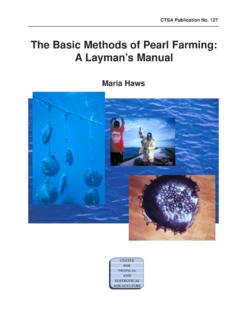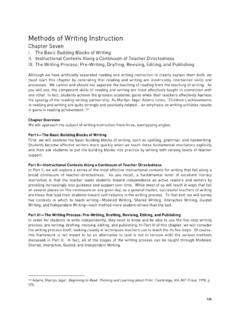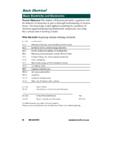Transcription of Mark E. Glickman and David A. van Dyk
1 319 From: methods in Molecular Biology, vol. 404: Topics in BiostatisticsEdited by: W. T. Ambrosius Humana Press Inc., Totowa, NJ16 Basic Bayesian MethodsMark E. Glickman and David A. van DykSummaryIn this chapter, we introduce the basics of Bayesian data analysis. The key ingredients to a Bayesian analysis are the likelihood function, which refl ects information about the parameters contained in the data, and the prior distribution, which quantifi es what is known about the parameters before observing data. The prior distribution and likelihood can be easily combined to from the posterior distribution, which represents total knowledge about the parameters after the data have been observed.
2 Simple summaries of this distribution can be used to isolate quantities of interest and ultimately to draw substantive conclusions. We illustrate each of these steps of a typical Bayesian analysis using three biomedical examples and briefl y discuss more advanced topics, including prediction, Monte Carlo computational methods , and multilevel Words: Monte Carlo simulation; posterior distribution; prior distribution; subjective IntroductionAs with most academic disciplines, researchers and practitioners often choose from among several competing schools of thought. In music, for example, some composers have been guided by the rules of Romanticism, Impressionism, or Atonality in developing their work; in art, painters have at various periods fol-lowed the rules of Cubism, Expressionism, or Dadaism with widely differing results.
3 One might assume that a scientifi c discipline such as statistics is immune to such philosophical divides. Interestingly, this is not the case. Statistics, as a discipline, consists of two main competing schools of thought: The frequentistor classical approach to statistical inference, and the Bayesian approach. The frequentist approach, which includes hypothesis testing and confi dence inter-vals as two of the main modes of inference, has been the main framework for 320 Glickman and van Dykmost of the techniques discussed thus far in this book. We discuss the basics of the Bayesian approach in this underlying difference between the Bayesian and frequentist approaches to statistical inference is in the defi nition of probability.
4 A frequentist views probability as a long-run frequency. When a frequentist asserts that the proba-bility of a fair coin tossed landing heads is 1-2, he means that in the long run, over repeated tosses, the coin will land heads half the time. In contrast, a Baye-sian, who will also surely say that the probability a coin lands heads is 1-2, is expressing a degree of belief that the coin lands heads, perhaps arguing that based on the symmetry of the coin there is no reason to think that one side is more likely to come up than the other side. This defi nition of probability is usually termed subjective probability. Whereas, in practice, a frequentist uses probability to express the frequency of certain types of data to occur over repeated trials, a Bayesian uses probability to express belief in a statement about unknown defi nitions have profound impact on a framework for statistical infer-ence.
5 Because a Bayesian uses subjective probability, he can describe uncer-tainty of a statement about an unknown parameter in terms of probability. A frequentist cannot. So, for example, it is legitimate for a Bayesian to conclude as a result of a data analysis that an interval contains a parameter of interest with 95% probability. A frequentist, in contrast, will use probability to describe how often the calculations that produce an interval will cover the parameter of interest in repeated samples. For instance, frequentist 95% confi dence intervals have the property that, in the long run, 95% of such intervals will cover the parameters being estimated.
6 But, unfortunately for the frequentist, once a set of data is observed and an interval is computed, the frequentist concept of prob-ability is no longer relevant. Further, when a Bayesian is evaluating two com-peting hypotheses about an unknown parameter, he can calculate the probability of each hypothesis given observed data and then choose the hypothesis with the greater probability. A frequentist, on the other hand, cannot use probability in such a direct way, and instead will approach the problem asymmetrically and ponder the long-run frequency under one of the hypotheses of sampling data as extreme or more extreme than what was chapter describes the basics of Bayesian statistics.
7 We begin by describ-ing the main ingredients of a Bayesian analysis. In this discussion, we explain how to obtain the posterior distribution of model parameters and how to obtain useful model summaries and predictions for future data. We then demonstrate an application of the Bayesian approach to multilevel models, using MonteCarlo simulation as a computational tool to obtain model Fundamentals of a Bayesian AnalysisA typical Bayesian analysis can be outlined in the following Bayesian methods 321 1. Formulate a probability model for the data. 2. Decide on a prior distribution, which quantifi es the uncertainty in the values of the unknown model parameters before the data are observed.
8 3. Observe the data, and construct the likelihood function (see Section ) based on the data and the probability model formulated in step 1. The likelihood is then combined with the prior distribution from step 2 to determine the posterior dis-tribution, which quantifi es the uncertainty in the values of the unknown model parametersafter the data are observed. 4. Summarize important features of the posterior distribution, or calculate quantities of interest based on the posterior distribution. These quantities constitute statistical outputs, such as point estimates and discuss each of these steps in turn in Sections main goal of a typical Bayesian statistical analysis is to obtain the pos-terior distribution of model parameters.
9 The posterior distribution can best be understood as a weighted average between knowledge about the parameters before data is observed (which is represented by the prior distribution) and the information about the parameters contained in the observed data (which is represented by the likelihood function). From a Bayesian perspective, just about any inferential question can be answered through an appropriate analysis of the posterior distribution. Once the posterior distribution has been obtained, one can compute point and interval estimates of parameters, prediction inference for future data, and probabilistic evaluation of hypotheses. Predictive inference is the topic of Section Data ModelsThe fi rst step in a Bayesian analysis is to choose a probability model for the data.
10 This process, which is analogous to the classic approach of choosing a data model, involves deciding on a probability distribution for the data if the parame-ters were known. If the n data values to be observed are y1, .. , yn, and the vector of unknown parameters is denoted q, then, assuming that the observations are made independently, we are interested in choosing a probability function p(yi | q)for the data (the vertical bar means conditional on the quantities to the right). In situations where we have extra covariate information, xi, for the ith case, as in regression models, we would choose a probability function of the form p(yi | xi,q).When the data are not conditionally independent given the parameters and covari-ates, we must specify the joint probability function, p(y1.)










